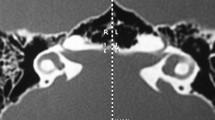Abstract
Objective
To present and analyse the radiological findings, surgical findings, pre-implantation and post-implantation speech and hearing outcomes of nine children with SMS Type III cochleovestibular malformation.
Study design
Retrospective case series of nine children with pre-lingual profound sensorineural hearing loss who underwent cochlear implantation (Jan 2012 to July 2019). These children had been classified as Type III malformation according to the SMS Classification of cochleovestibular anomalies. Facial nerve anomalies, CSF leaks and any other significant surgical finding were noted. Meaningful Auditory Integration Scale (MAIS) was used to report the child’s pre-operative and two-year post-implantation auditory and speech abilities. Any significant improvement was assessed using the Wilcoxon signed rank test. P value < 0.05 was considered significant.
Results
Out of nine patients, five patients sustained CSF gushers, while three patients had mild CSF leak, which were plugged adequately. No facial nerve anomalies were encountered. Post-op course was uneventful for all nine patients. MAIS scores at a two-year follow-up showed significant statistical improvement (P < 0.05) when compared to pre-operative scores.
Conclusion
Cochlear implant is the treatment of choice for children with type III cochleovestibular malformation. There are significant auditory and speech improvements expected. However, the surgeon should bear in mind the risk of CSF leak and subsequent meningitis.


Similar content being viewed by others
References
Sennaroglu L, Saatci I (2002) A new classification for cochleovestibular malformations. Laryngoscope 112(12):2230–2241
Grover M et al (2019) New SMS classification of cochleovestibular malformation and its impact on decision-making. J Laryngol Otol 133(5):368–375
Sennaroglu L, Sarac S, Ergin T (2006) Surgical results of cochlear implantation in malformed cochlea. Otol Neurotol 27(5):615–623
Sennaroglu L, Bajin MD (2018) Incomplete partition type III: a rare and difficult cochlear implant surgical indication. Auris Nasus Larynx 45(1):26–32
McClay JE, Booth TN, Parry DA, Johnson R, Roland P (2008) Evaluation of pediatric sensorineural hearing loss with magnetic resonance imaging. Arch Otolaryngol Head Neck Surg 134(9):945–952
Phelps PD, King A, Michaels L (1994) Cochlear dysplasia and meningitis. Am J Otol 15(4):551–557
Sennaroglu L (2010) Cochlear implantation in inner ear malformations—a review article. Cochlear Implants Int 11(1):4–41
Loundon N, Rouillon I, Munier N, Marlin S, Roger G, Garabedian EN (2005) Cochlear implantation in children with internal ear malformations. Otol Neurotol 26(4):668–673
Farhood Z, Nguyen SA, Miller SC, Holcomb MA, Meyer TA, Rizk HG (2017) Cochlear implantation in inner ear malformations: systematic review of speech perception outcomes and intraoperative findings. Otolaryngol Neck Surg 156(5):783–793
Berrettini S, Forli F, De Vito A, Bruschini L, Quaranta N (2013) Cochlear implant in incomplete partition type I. Acta Otorhinolaryngol Ital 33(1):56–62
Eisenman DJ, Ashbaugh C, Zwolan TA, Arts HA, Telian SA (2001) Implantation of the malformed cochlea. Otol Neurotol 22(6):834–841
Vashist S, Singh S (2016) CSF Gusher in Cochlear Implant Surgery-does it affect surgical outcomes? Eur Ann Otorhinolaryngol Head Neck Dis 133(Suppl):S21–S24
Kim L-S, Jeong S-W, Huh M-J, Park Y-D (2006) Cochlear implantation in children with inner ear malformations. Ann Otol Rhinol Laryngol 115(3):205–214
El-Anwar MW, ElAassar AS, Foad YA (2016) Non-mastoidectomy cochlear implant approaches: a literature review. Int Arch Otorhinolaryngol 20:180–184
Tay SY, Anicete R, Tan KKH (2019) A ten-year review of audiological performance in children with inner ear abnormalities after cochlear implantation in Singapore. Int J Otolaryngol 2019:6483714
Ciorba A et al (2012) Postoperative complications in cochlear implants: a retrospective analysis of 438 consecutive cases. Eur Arch Otorhinolaryngol 269(6):1599–1603
Buchman CA, Copeland BJ, Yu KK, Brown CJ, Carrasco VN, Pillsbury HC 3rd (2004) Cochlear implantation in children with congenital inner ear malformations. Laryngoscope 114(2):309–316
Chadha NK, James AL, Gordon KA, Blaser S, Papsin BC (2009) Bilateral cochlear implantation in children with anomalous cochleovestibular anatomy. Arch Otolaryngol Head Neck Surg 135(9):903–909
Jeong S-W, Kim L-S (2015) A new classification of cochleovestibular malformations and implications for predicting speech perception ability after cochlear implantation. Audiol Neurootol 20(2):90–101
Connor CM, Craig HK, Raudenbush SW, Heavner K, Zwolan TA (2006) The age at which young deaf children receive cochlear implants and their vocabulary and speech-production growth: is there an added value for early implantation? Ear Hear 27(6):628–644
Funding
None.
Author information
Authors and Affiliations
Contributions
All authors contributed to the study conception and design. Material preparation, data collection and analysis were performed by MG and AK. The first draft of the manuscript was written by AK and all authors commented on previous versions of the manuscript. All authors read and approved the final manuscript.
Corresponding author
Ethics declarations
Conflict of interest
The authors declare that they have no conflict of interest.
Ethics approval
Ethics approval was not required as it was a retrospective case series and the intervention performed is part of the routine care.
Informed consent
A written informed consent was obtained from the parents of the children who participated in this study. A written informed consent was obtained from the parents of the children whose data has been published.
Additional information
Publisher's Note
Springer Nature remains neutral with regard to jurisdictional claims in published maps and institutional affiliations.
Rights and permissions
About this article
Cite this article
Grover, M., Kanodia, A., Gupta, G. et al. Application of the new SMS system of cochleovestibular anomalies: our experience with nine cases of type III anomaly. Eur Arch Otorhinolaryngol 278, 659–664 (2021). https://doi.org/10.1007/s00405-020-06114-4
Received:
Accepted:
Published:
Issue Date:
DOI: https://doi.org/10.1007/s00405-020-06114-4




